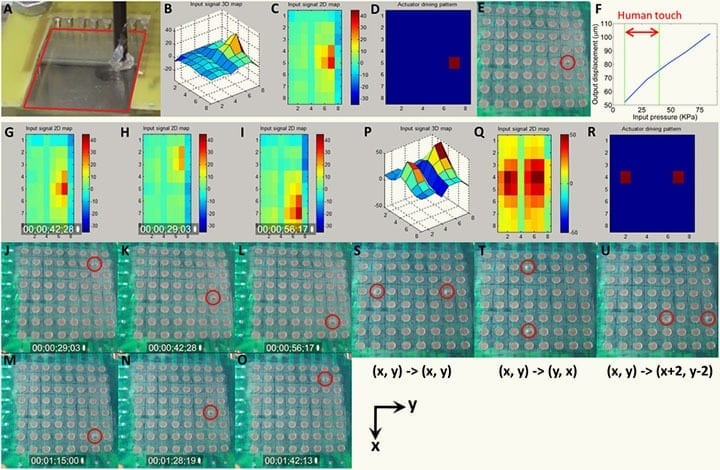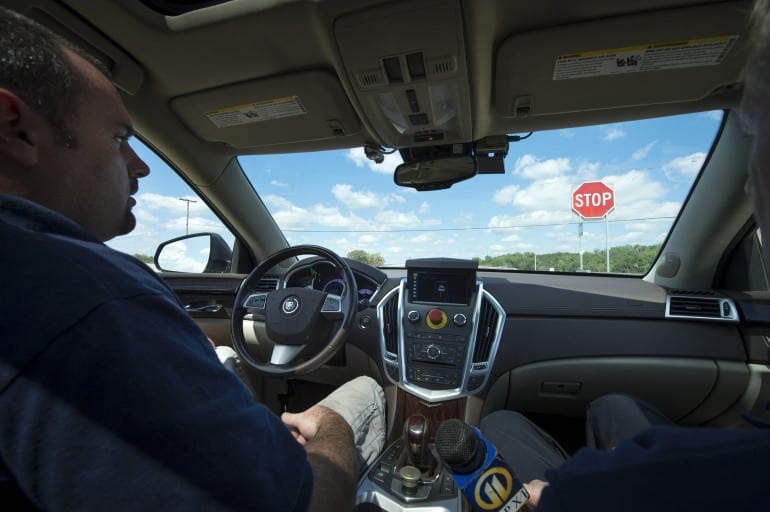
After touch screens, researchers demonstrate electronic recording and replay of human touch
Researchers at the University of California, San Diego report a breakthrough in technology that could pave the way for digital systems to record, store, edit and replay information in a dimension that goes beyond what we can see or hear: touch.
“Touch was largely bypassed by the digital revolution, except for touch-screen displays, because it seemed too difficult to replicate what analog haptic devices – or human touch – can produce,” said Deli Wang, a professor of Electrical and Computer Engineering (ECE) in UC San Diego’s Jacobs School of Engineering. “But think about it: being able to reproduce the sense of touch in connection with audio and visual information could create a new communications revolution.”
In addition to uses in health and medicine, the communication of touch signals could have far-reaching implications for education, social networking, e-commerce, robotics, gaming, and military applications, among others. The sensors and sensor arrays reported in the paper are also fully transparent (see optical image of transparent ZnO TFT sensor array at right), which makes it particularly interesting for touch-screen applications in mobile devices.
“Our sense of touch plays a significant role in our daily lives, particularly in personal interaction, learning and child development, and that is especially true for the development of preemies,” said Nguyen, another senior author of this Scientific Reports paper. “We were approached by colleagues in the UC San Diego School of Medicine’s neonatology group to see if there was a way to record a session of a mother holding the baby, which could be replayed at a different time in an incubator.”
In their Scientific Reports paper, the researchers reported the electronic recording of touch contact and pressure using an active-matrix pressure sensor array made of transparent zinc-oxide (ZnO), thin-film transistors (TFTs). The companion tactile feedback display used an array of diaphragm actuators made of an acrylic-based dielectric elastomer with the structure of an interpenetrating polymer network (IPN). The polymer actuators’ actuation – the force and level of displacement – are modulated by adjusting both the voltage and charging time.
One of the critical challenges in developing touch systems is that the sensation is not one thing. It can involve the feeling of physical contact, force or pressure, hot and cold, texture and deformation, moisture or dryness, and pain or itching. “It makes it very difficult to fully record and reproduce the sense of touch,” said Wang.
The Latest Bing News on:
Touch systems
- Washington has lost touch with reality. If it doesn’t adapt, the world will payon April 30, 2024 at 11:57 am
In a failing quest to maintain its 'primacy', the US has cast an anxious China, confrontational Russia and Iran as global villains.
- Scattered showers, storms bring temperatures down a touch Tuesdayon April 30, 2024 at 4:24 am
Scattered showers and storms favor the western half of the area Tuesday afternoon and evening. Afternoon highs, therefore, will be kept (somewhat) in check.
- Medit launches the revolutionary i900, an intraoral scanning system set to redefine the scanning experience for dental clinics worldwideon April 30, 2024 at 12:11 am
The Medit i900 is powered by Medit Link, the company's open software platform, providing access to a suite of free dental apps that encourage productivity and enhance patient care. The system provides ...
- Touch Screens Are Ruining Carson April 29, 2024 at 1:33 pm
On the level of aesthetics, the supposed innovations have led only to conformity and mediocrity. Even the interior of a new Mercedes-Benz S-class, luxurious as it is, with its immersive flatscreens ...
- Yale Assure Lock 2 Touch picks up new features with the Z-Wave Smart Moduleon April 29, 2024 at 11:17 am
When installed, the module lets the Assure Lock 2 Touch sync with Samsung SmartThings, Amazon Alexa, Hey Google, and Siri. You can also sync the lock with various smart lights and security systems ...
- Fixing Apple Watch False Touch & Ghost Touch Issueson April 26, 2024 at 9:19 am
Some Apple Watch users have experienced a situation where their Apple Watch seems to respond to phantom touches, which some users have come to call ghost touches. These false touches can happen in ...
- Global Automotive Surround View Systems Market Poised for Substantial Growth, Reaching US$ 18.7 Billion by 2032on April 26, 2024 at 6:12 am
Unilever reported underlying sales growth of 4.4% in the first quarter (Q1) of 2024. The company attributed this growth to an increase in volume growth, which rose to 2.2% in Q1 compared to 1.8% in ...
- Legal system accused of being ‘soft touch’ on drug offenderson April 25, 2024 at 4:01 pm
The Scottish legal system no longer imposes tough sentences on drug dealers, a sheriff has suggested. James MacDonald criticised social workers for recommending a “soft-touch” sentence as punishment f ...
- Atlona adds 7” touch panel to Velocity family of AV controlson April 25, 2024 at 8:59 am
Similar to Atlona’s 10-inch panels, the VTP-700VL can function as the primary AV control interface for corporate meeting spaces, or classrooms ...
- maXTouch® Touchscreen Controller Family Expands with Additional Security Features for Touchscreen Payment Systemson April 25, 2024 at 1:09 am
Typical touch-enabled human machine interface (HMI) and radio frequency identification (RFID) combination-based payment systems are vulnerable to hacking attacks via malicious software updates or ...
The Latest Google Headlines on:
Touch systems
[google_news title=”” keyword=”touch systems” num_posts=”10″ blurb_length=”0″ show_thumb=”left”]
The Latest Bing News on:
Touch signals
- Rita Ora’s sheer opera gloves signal a very chic spring trendon April 30, 2024 at 3:42 am
If you're looking to add a touch of drama or adopt a feeling of Bridgerton-esque regency, elbow-length gloves are a quick way to achieve it. Rather than the winter variety intended to provide warmth ...
- Favourable Signals For Crown Crafts: Numerous Insiders Acquired Stockon April 29, 2024 at 10:32 pm
Generally, when a single insider buys stock, it is usually not a big deal. However, when several insiders are buying, like in the case of Crown Crafts, Inc. (NASDAQ:CRWS), it sends a favourable ...
- FCC signals broader agenda on national security, public safety, and more in Net Neutrality rulingon April 28, 2024 at 5:00 pm
Any of these policy developments will mark both a significant departure from the FCC’s historical “light-touch” regulation of BIAS and a foray into new areas of regulation that will likely be tested ...
- Numbness and tingling could signal nerve damageon April 28, 2024 at 1:19 am
Pins and needles or sharp pains could be warning signs of nerve damage, a condition that might be more common than many think.
- Favourable Signals For Patriot Lithium: Numerous Insiders Acquired Stockon April 27, 2024 at 9:06 am
When a single insider purchases stock, it is typically not a major deal. However, when multiple insiders purchase stock, like in Patriot Lithium Limited's (ASX:PAT) instance, it's good news for ...
- Texas Power Prices Signal Grid Stress in Another Long, Hot Summeron April 27, 2024 at 6:31 am
A surge in Texas power prices for August suggests another summer of heavy electricity demand — and potential grid strain — to meet air-conditioning needs.
- What Express filing for bankruptcy signals about Gen Z shopping habitson April 26, 2024 at 12:49 pm
In a news release, the Express CEO signaled that the filing came as the company seeks to strengthen its financial position: “We continue to make meaningful progress refining our product assortments, ...
- How NFL experts graded the Bears' selection of WR Rome Odunzeon April 26, 2024 at 7:30 am
We’ve rounded up the grades for the Bears’ first-round selection of WR Rome Odunze, where experts agreed they got an absolute steal at No. 9.
- Four signals Queen Mary & King Frederik send with ‘wooden’ new portrait after affair rumours, claims body language proon April 25, 2024 at 6:09 am
THE first official portrait of King Frederik and Queen Mary has been unveiled following their ascension to the throne in January this year. The Danish royal couple looked resplendent in their ...
- Curiosity Rover Enjoys Martian Spring with ‘Touch-and-Go’ Operationson April 24, 2024 at 4:12 pm
Much like someone eager to cultivate their earthly garden, Curiosity too possesses bountiful energy reserves. The rover’s recent ‘touch-and-go’ mission exploits this surplus, allowing it to engage ...
The Latest Google Headlines on:
Touch signals
[google_news title=”” keyword=”touch signals” num_posts=”10″ blurb_length=”0″ show_thumb=”left”]









